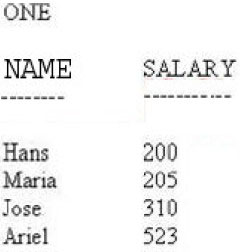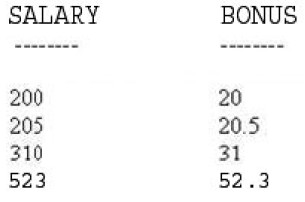SAS Advanced Programming for SAS 9 v1.0
Question 1
The following SAS program is submitted:
data temp;
set sasuser.history(kep=date);
format date qtr
<insert BY statement here>
if first.date then total=0;
total+1;
if last.date;
run;
proc print data=temp;
run
SASUSER.HISTORY is sorted by the SAS date variable DATE.
The following output is required:
Date Total -
1 13
3 15
4 25
Which By statement completes the data step and successfully generates the required output?
- A. by groupformat date;
- B. by formateed date;
- C. by notsorted date;
- D. by date qtr
Answer : A
Question 2
Which statement(s) in the DATASETS procedure alter(s) the name of a SAS data set stored in a SAS data library?
- A. MODIFY and CHANGE statements
- B. RENAME statement only
- C. CHANGE statement only
- D. MODIFY and RENAME statements
Answer : C
Question 3
Given has SAS dataset ONE:

The following SAS program is submitted:

Proc sql;
<insert SQL clause here>
from one;
quit;
The following output is desired:
Which SQL procedure clause completes the program and generates the desired output?
- A. Select salary, salary*.10 var=BONUS
- B. Select salary, salary*.10 label='BONUS'
- C. Select salary, salary *.10 column='BONUS'
- D. Select salary, salary*.10 name='BONUS'
Answer : B
Question 4
Given the non-indexed SAS data set TEMP:
TEMP -
X Y -
- -
P 52 -
P 45 -
A 13 -
A 56 -
R 34 -
R 12 -
R 78 -
The following SAS program is submitted:
Proc print data=temp;
<insert BY statement here>
run;
Which BY statement completes the program, creates a listing report that is grouped by X and completes without errors?
- A. By X notsorted;
- B. By X grouped;
- C. By Descending X;
- D. By X;
Answer : A
Question 5
Given the data set SASHELP.CLASS
SASHELP.CLASS -
NAME AGE -
Mary 15 -
Philip 16 -
Robert 12 -
Ronald 15 -
The following SAS program is submitted
%let value = Philip;
proc print data =sashelp.class;
<insert Where statement here>
run;
Which WHERE statement successfully completes the program and produces a report?
- A. Where upcase(name)="upcase(&value)";
- B. Where upcase(name)="%upcase(&value)";
- C. Where upcase(name)=upcase(&value);
- D. Where upcase(name)=%upcase(&value);
Answer : B
Question 6
Following SAS program is submitted:
data temp(<insert option here>);
infile 'rawdata';
input x $ y z;
run;
RAWDATA is a file reference to an external file that is ordered by the variable X.
Which option specifies how the data in the SAS data set TEMP will be sorted?
- A. ORDEREDBY=X
- B. GROUPBY=X
- C. SORTEDBY=X
- D. SORTSYNC=X
Answer : C
Question 7
Given the following partial SAS log:
NOTE: SQL table SASHELP.CLASS was created line
Create table SASHELP.CLASS(bufsize=4096)
(
Name char(8);
Gender Char(1);
Age num;
Height num;
Weight num -
);
Which SQL procedure statement generated this output?
- A. DESCRIBE TABLE
- B. LIST TABLE
- C. VALIDATE TABLE
- D. CREATE TABLE
Answer : A
Question 8
The following SAS program is submitted:
options mprint;
%macro test(parm);
proc &parm data = sashelp.prdsale;
run;
%mend;
%test(print)
What is the result of the MPRINT options?
- A. It has no effect in this example
- B. It writes the original program code inside the marco definition to the SAS log
- C. It writes macro execution messages to the SAS.log
- D. It echoes the text sent to the SAS compiler as a result of macro execution in the SAS log
Answer : D
Question 9
Given the SAS data set ONE:
ONE -
REP COST -
SMITH 200 -
SMITH 400 -
JONES 100 -
SMITH 600 -
JONES 100 -
The following SAS program is submitted:
Proc sql;
Select rep, avg(cost) as AVERAGE
From one -
Group by rep -
<insert SQL procedure clause here>
quit;
The following output is desired:

Which SQL procedure clause completes the program and generates the desired output?
- A. having avg(cost) < select avg(cost) from one);
- B. Having avg(cost)>(select avg(cost) from one);
- C. Where avg(cost)>(select avg(cost) from one);
- D. Where calculated average > (select avg(cost) from one);
Answer : B
Question 10
Given the data set SASHELP.CLASS:
SASHELP.CLASS -
NAME AGE -
Mary 15 -
Philip 16 -
Robert 12 -
Ronald 15 -
The following SAS program is submitted:
%let value = Philip;
proc print data = sashelp.class;
<insert WHERE statement here>
run;
Which WHERE statement successfully completes the program and procedures a report?
- A. Where upcase(name)=%upcase(&value);
- B. Where upcase(name)="upcase(&value)";
- C. Where upcase(name)=upcase(&value);
- D. Where upcase(name)="%upcase(&value)";
Answer : D
Question 11
Given the SAS dataset ONE -
ONE -
SALARY -
200
205
523
The following SAS program is submitted
Proc sql;
Select * from one -
<Insert Where expression here>;
quit;
The following output is desired:
SALARY -
200
205
523
Which WHERE expression completes the program and generates the desired output?
- A. Where salary is not
- B. Where salary ne null
- C. Where salary is not missing
- D. Where salary ne missing
Answer : C
Question 12
At the start of a new SAS session; the following program is submitted:
%macro one;
data _null_;
call symput('proc','measn);
run;
proc &proc data=sashelp.class;
run;
%mend;
%one()
What is the result?
- A. The marco variable PRCO is stored in the SAS catalog WORK.SASMACR
- B. The program fails to execute because PROC is a reserved word
- C. The macro variable PROC is stored in the local symbol table
- D. The macro variable PROC is stored in the global symbol table
Answer : D
Question 13
The following SAS program is submitted:
%let value=9;
%let add=5;
%let newval=%eval(&value/&add);
What is the value of the macro variable NEWVAL?
- A. null
- B. 2
- C. 1
- D. 1.8
Answer : C
Question 14
Given the non-indexed SAS data set TEMP:
TEMP -
X Y -
P 52 -
P 45 -
A 13 -
A 56 -
R 34 -
R 12 -
R 78 -
The following SAS program is submitted:
Proc print data=temp;
<insert By statement here?
Run;
Which by statement completes the program, create a listing report that is grouped by X and completes without errors?
- A. X;
- B. By X groupd;
- C. By X notsorted;
- D. By descending X;
Answer : C
Question 15
Which of the following is true about the COMPRESS=YES data set option?
- A. It is most effective with numeric data that represents large numeric values
- B. It is most effective with character data that contains patterns, rather than simple repetitions
- C. It uses the Ross Data Compression method to compress numeric data
- D. It is most effective with character data that contains repeated characters
Answer : D